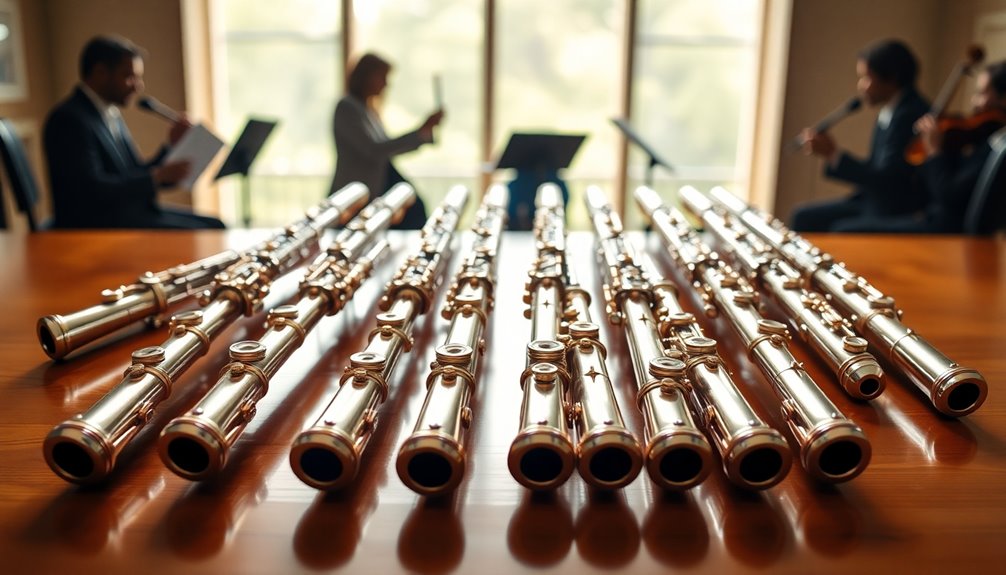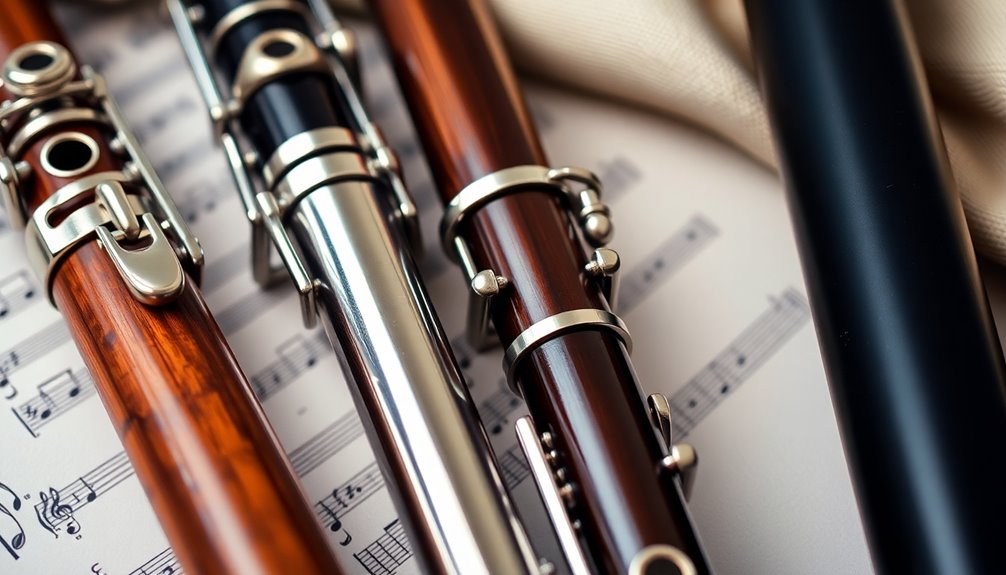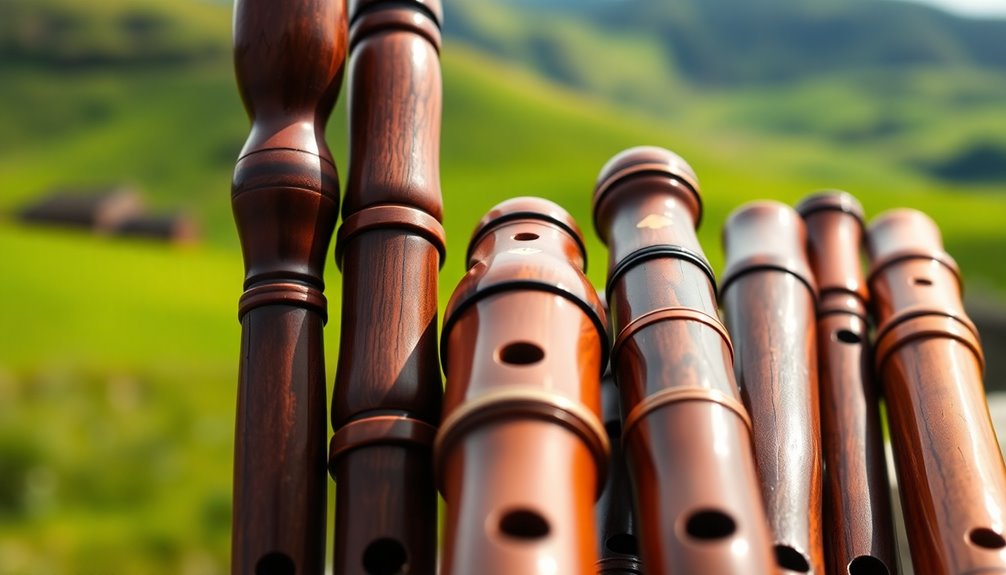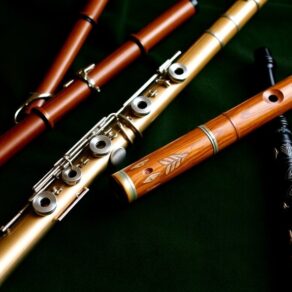Flute varieties, such as the versatile concert flute, deliver a wide range of expressive capabilities. You'll find the piccolo's bright, piercing tones complement orchestral arrangements, while the alto flute offers a warm timbre, ideal for lyrical passages. The bass flute resonates with rich depth, making it perfect for contemporary compositions. The Native American flute connects deeply with cultural narratives through haunting melodies. Meanwhile, traditional options like the Baroque flute and Irish wooden flute evoke historical significance, each with unique tonal qualities. Exploring these multifaceted flutes reveals fascinating insights into their distinctive sounds and cultural roles.
Key Takeaways
- The concert flute offers a versatile sound, allowing rich expression across various genres with a wide repertoire.
- The piccolo produces a bright, piercing tone, playing an octave higher than the concert flute, ideal for orchestral dynamics.
- The alto flute has a warm, rich sound, perfect for lyrical passages, enhancing emotional expression in music.
- The bass flute features a resonant tone with depth, showcasing unique tonal qualities that enrich contemporary and classical compositions.
- The Native American flute emits haunting melodies with distinct tonal qualities, deeply connected to spiritual narratives and traditional storytelling.
Concert Flute

The concert flute, typically made of metal or sometimes wood, stands out as one of the most versatile instruments in the woodwind family. Its design allows for a rich range of expression, making it a favorite among both amateur and professional musicians.
When you investigate concert flute techniques, you'll discover a plethora of methods that enhance your playing. Techniques like vibrato, flutter tonguing, and harmonics add depth and character to your performances. Mastering these techniques not only broadens your expressive palette but also elevates your overall musicianship.
In terms of concert flute repertoire, you'll find an extensive collection of works spanning various genres and periods. From the intricate sonatas of Bach to contemporary compositions, the repertoire offers something for everyone. Engaging with this diverse selection invites you to connect with different musical traditions and styles, fostering a sense of belonging within the broader musical community.
As you probe deeper into these techniques and pieces, you'll likely find that your understanding of music will grow. Each note you play becomes a part of a larger conversation among musicians, past and present.
Embracing the concert flute not only enriches your personal expression but also allows you to engage with a global network of flutists. In this journey, you'll discover that the concert flute isn't just an instrument; it's a bridge that connects you with the rich tapestry of musical history and community. Additionally, having a solid understanding of key mechanisms can significantly enhance your playing experience and adaptability with different flute types.
Piccolo

Often considered the concert flute's smaller counterpart, the piccolo commands attention with its bright, penetrating sound. Its unique voice, an octave higher than the concert flute, allows it to stand out in orchestral arrangements and solo performances alike.
The piccolo's history dates back to the early 18th century, evolving from simpler wooden instruments to the sophisticated metal designs we see today. Understanding this evolution gives you a deeper appreciation for its role in both classical and contemporary music.
When you explore piccolo techniques, you'll discover that mastering this instrument requires specific skills. The small size demands precise finger placement and breath control, as even the slightest miscalculation can lead to sharp or flat notes.
Fingerings differ slightly from the concert flute, and you'll need to practice regularly to develop the dexterity required to navigate rapid passages. Articulation techniques such as staccato and legato are essential for achieving the dynamic range that the piccolo can offer.
Additionally, the piccolo's role in ensembles often involves playing melodies that soar above the orchestra, providing a brilliant counterpoint to the harmonies below. This prominence fosters a sense of belonging within a musical community, as you contribute to the overall texture of the performance.
Ultimately, the piccolo isn't just a smaller flute; it's a powerful instrument that requires dedication and skill, inviting you to engage with its rich history and vibrant sound profile. To maintain its performance, using tools like the Altieri Black Piccolo Wand ensures effective moisture removal and prolongs the instrument's lifespan.
Alto Flute

Exploring the alto flute reveals an enchanting blend of warmth and richness in its sound profile, distinct from both the concert flute and piccolo. This unique voice invites musicians to investigate a diverse repertoire, expanding their musical horizons. If you're seeking to master alto flute techniques, you'll find that the instrument's lower pitch allows for a deeper expression of musical ideas, making it a favorite among seasoned players.
The table below highlights some key aspects of the alto flute:
| Aspect | Details |
|---|---|
| Range | Typically from G3 to C7, offering a rich lower sound |
| Timbre | Warm and mellow, perfect for soft, lyrical passages |
| Common Techniques | Vibrato, flutter tongue, and harmonics |
| Repertoire | Includes works by composers like Bach and Tchaikovsky |
When you explore alto flute techniques, you'll discover how to manipulate breath control and fingerings to achieve those lush tones. The repertoire for the alto flute is often characterized by its lyrical and expressive nature, allowing you to connect emotionally with your audience. Pieces like "Concerto for Alto Flute" by A. M. G. P. provide a platform for showcasing these techniques. Additionally, the alto flute's rich, mellow tones make it a popular choice in both solo performances and chamber music settings.
As you embrace the alto flute, you'll not only enhance your musicianship but also cultivate a sense of belonging within a rich tradition of flute playing. The alto flute's unique sound invites you to share your musical journey with others, creating lasting connections through the power of music.
Bass Flute

Mastering the bass flute offers a fascinating journey into the depths of sound, characterized by its rich, resonant tones and expansive range. As you explore this unique instrument, you'll discover that its lower register allows for a variety of expressive possibilities.
Bass flute techniques are essential for achieving the instrument's full potential. You'll want to focus on breath control, embouchure adjustments, and finger placements to navigate its lower notes effectively.
Incorporating techniques like legato and staccato playing can enhance your expressiveness, enabling you to create a wide array of musical textures. The bass flute's ability to blend seamlessly with other woodwinds makes it an integral part of any ensemble, allowing you to contribute to harmonic foundations and melodic lines alike.
The bass flute repertoire is rich and diverse, ranging from contemporary compositions to arrangements of classical masterpieces. You'll find works that challenge your technical skills while allowing for emotional interpretation.
Composers often exploit the instrument's unique tonal qualities, which can evoke both warmth and depth. As you explore this repertoire, you'll not only develop your musicianship but also establish a sense of belonging within the broader flute community.
Engaging with fellow musicians who share a passion for the bass flute can lead to collaborative opportunities, enriching your performance experience. Additionally, understanding the key features and options of bass flutes can significantly enhance your playing experience. Embrace this journey, and you'll find that the bass flute opens up new dimensions in your musical expression.
Native American Flute

The Native American flute captivates with its distinct tonal qualities and cultural significance, offering a unique window into the traditions and musical expressions of Indigenous peoples. This instrument, often crafted from wood or bone, embodies a rich history that resonates deeply with the spiritual and communal aspects of Native American life.
- Cultural Heritage: Each flute is a reflection of the artisan's skills and the stories of their people.
- Unique Sound: The flute produces haunting melodies that evoke nature and emotion.
- Playing Techniques: Mastering breath control and finger positioning enhances the flute's enchanting sound.
When you investigate the Native American flute, you'll discover not only its melodic capabilities but also the storytelling tradition it upholds. Each note played can reflect a connection to nature, love, or loss, illustrating the profound relationship between music and life experiences in Indigenous cultures.
The playing techniques vary widely, often influenced by regional styles and personal expression. You might find that breath control is essential for generating the flute's characteristic tones, requiring you to engage deeply with your own breath and emotions.
Finger positioning also plays a vital role; the way you cover the holes can greatly alter the pitch and timbre.
As you explore this instrument, you'll appreciate its ability to create a sense of belonging, bridging gaps between cultures and inviting you to participate in an age-old musical dialogue that transcends time and space. Additionally, the choice of materials, such as high-quality woods, significantly impacts the flute's sound quality and durability.
Baroque Flute

While the Native American flute offers a deeply spiritual connection to nature and storytelling, the Baroque flute presents a contrasting yet equally rich musical experience rooted in the European classical tradition. Emerging in the early 18th century, the Baroque flute, typically made of wood, boasts a cylindrical bore that contributes to its warm, mellow timbre. Its historical significance can't be overstated, as it played a key role in the development of Western classical music, influencing composers like Bach and Handel.
When you explore the Baroque flute, you'll encounter various baroque techniques that distinguish its sound. The use of vibrato, for instance, adds expressiveness, allowing performers to convey nuanced emotions. Articulation methods, such as tongueing and slurring, further enhance the instrument's capabilities, enabling a fluidity of expression that mirrors the intricacies of Baroque compositions.
Additionally, the instrument's range—typically spanning over two octaves—invites you to experiment with dynamics and phrasing, deepening your connection to the music. The Baroque flute's unique sound profile often evokes a sense of nostalgia and elegance, drawing listeners into a world of ornate musical dialogues. Understanding the acoustical properties of the Baroque flute can significantly enhance your ability to produce rich, multifaceted tones.
As you immerse yourself in the repertoire, from solo sonatas to ensemble works, you'll find a vibrant community of musicians passionate about reviving this historical instrument. Engaging with the Baroque flute not only enriches your musical journey but also connects you to a rich cultural legacy that continues to inspire today's artists.
Irish Wooden Flute

Exploring the world of the Irish wooden flute reveals an instrument steeped in tradition and characterized by its distinct, bright sound. This flute, often crafted from indigenous woods like African blackwood or boxwood, has a rich Irish flute history that connects deeply to the cultural fabric of Ireland. As you uncover its nuances, you'll appreciate how it has become a cornerstone of traditional Irish music.
- It produces a warm, resonant tone that's perfect for lively jigs and haunting ballads.
- The instrument's design allows for expressive ornamentation, enhancing the emotional depth of performances.
- Its versatility makes it suitable for both solo and ensemble settings, fostering community through music.
The Irish wooden flute's design is relatively simple, featuring six finger holes, which allows for a broad range of notes. This accessibility encourages musicians, from novices to seasoned players, to engage with the instrument and embrace the art of traditional Irish music.
Its historical roots trace back to the late 18th century, evolving from the simpler, more rustic flutes of earlier times. Additionally, the Irish wooden flute's craftsmanship mirrors the traditional craftsmanship(#) found in bamboo flutes, highlighting the significance of material quality in sound production.
As you explore playing the Irish wooden flute, you'll find that it not only connects you to the music of generations past but also invites you into a vibrant community of musicians. Your journey with this instrument can be transformative, allowing you to express yourself while honoring a rich cultural legacy.
Bansuri

Often regarded as one of the most enchanting woodwind instruments, the bansuri stands out for its ethereal sound and deep cultural significance in Indian music. Crafted from bamboo, this side-blown flute offers a warm, resonant tone that captivates listeners, creating an immediate sense of connection.
The bansuri's unique sound profile is intrinsically tied to the bansuri playing techniques, which require mastery of breath control, finger placement, and articulation.
When you investigate the nuances of bansuri playing, you'll find that traditional techniques such as "meend" (gliding between notes) and "gamak" (ornamentation) allow musicians to evoke a wide range of emotions. The bansuri's ability to mimic the human voice enhances its expressiveness, making it a favored instrument in both classical and folk music contexts.
Moreover, the bansuri's cultural significance is profound. It's often associated with divine narratives, particularly in the tales of Lord Krishna, who's frequently depicted playing the bansuri to enchant the gopis. This connection to spirituality infuses the music with a sense of purpose, inviting you to engage with a tradition that transcends mere performance.
As you explore the world of bansuri, you'll discover not just an instrument but a rich legacy that invites you to belong to a larger narrative—one that celebrates the beauty of sound, culture, and expression. The bansuri belongs to a family of flutes that includes the concert flute and the piccolo, each offering its unique timbre and role in music.
Embracing the bansuri means embracing a profound journey through the heart of Indian music.
Frequently Asked Questions
What Materials Are Commonly Used to Make Different Types of Flutes?
When you explore the materials used for making different types of flutes, you'll discover that wooden flutes often feature rich, warm tones, crafted from woods like grenadilla and bamboo.
In contrast, metal flutes, typically made from silver or nickel, produce a brighter, more penetrating sound.
Each material influences not just the tone but also the playing experience, so understanding these options helps you choose the flute that best aligns with your musical identity.
How Do Flute Sizes Affect Their Sound and Playability?
Flute dimensions greatly influence both sound projection and playability. A larger flute often produces a richer, deeper tone, while a smaller one offers a brighter, more focused sound.
You'll find that the size also affects your ability to reach certain notes comfortably. As you experiment with different sizes, you'll notice how each one changes your playing experience, allowing you to express yourself uniquely and connect more deeply with the music you create.
Can Flutes Be Used in Non-Traditional Music Genres?
Using flutes in non-traditional music genres is like painting outside the lines—it's all about creativity and exploration.
Flute fusion invites genre experimentation, allowing you to blend classical melodies with modern beats, jazz riffs, or world music influences.
By embracing diverse styles, you can create a unique sound that resonates with listeners.
This openness fosters a sense of belonging within a broader musical community, where every note contributes to a rich tapestry of cultural expression.
What Are the Best Maintenance Practices for Various Flutes?
To maintain your flute's performance, prioritize regular cleaning techniques. Wipe down the exterior after each use to prevent tarnishing, and use a cleaning rod with a soft cloth for the inside.
Repair tips include checking pads for wear; replace them if you notice leaks. Guarantee the keys are properly aligned, and consider professional servicing annually.
This routine not only enhances your instrument's longevity but also deepens your connection to your music.
How Do Cultural Influences Shape Flute Design and Sound?
Did you know that over 300 distinct flute types exist worldwide? Cultural influences shape flute design and sound through regional variations and cultural symbolism.
For instance, in Indigenous cultures, flutes often represent spiritual connections, while in classical Western music, design focuses on precision and projection.
These elements reflect the values and traditions of each culture, creating unique sounds that resonate deeply with their communities, fostering a sense of belonging and identity among musicians and listeners alike.
Conclusion
In exploring the diverse world of flute varieties, you've discovered how each instrument's unique construction influences its sound profile. Notably, the piccolo, often considered the highest-pitched flute, can reach frequencies up to 1,000 Hz, creating a bright, piercing tone that stands out in orchestras. This variation in sound not only enriches musical compositions but also highlights the cultural significance of each flute type. Embracing these differences can deepen your appreciation for the flute's role in music history.






